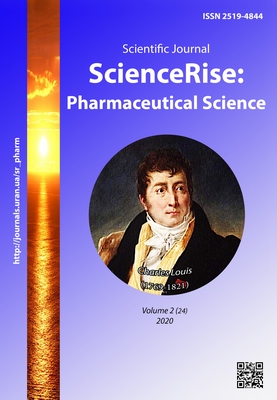Попередній вибір пребіотичного компоненту у складі комплексного дерматологічного лікувально-профілактичного засобу з пробіотиком
DOI:
https://doi.org/10.15587/2519-4852.2020.201104Ключові слова:
лактобактерії, пробіотики, пребіотики, мікробіом шкіри, дерматологічні захворювання, лікувально-профілактичний засібАнотація
Мета. Вибір оптимальних пребіотичних компонентів для бактерій роду Lactobacillus з метою їх сумісного використання у складі м’якого комплексного дерматологічного лікувально-профілактичного засобу з пробіотиком.
Методи. Сумісне культивування пробіотичного штаму у рідкому живильному середовищі МРС із певним активним інгредієнтом у обраних концентраціях. Протягом циклу культивування через певні проміжки часу відбирали зразки зростаючої культури для визначення концентрації бактерій методом прямого посіву і визначення кислотності.
Результати. Протягом 48 год сумісного культивування лактобактерій із обраними компонентами спостерігається суттєве збільшення життєздатних клітин, як в контролі, так і при додаванні вітамінів у обраних концентраціях (експоненціальна фаза росту бактерій), з 48 год до 60 год - зниження швидкості збільшення клітин як в контролі, так і в дослідах, кількість клітин залишається майже на постійному рівні (стаціонарна фаза росту бактерій), після 60 год - зменшення кількості клітин (фаза відмирання).
Протягом культивування відмічається закислення живильного середовища в результаті утворення з вуглеводів молочної кислоти та інших кінцевих метаболітів; тобто додання компонентів дещо підвищує біохімічний потенціал мікроорганізмів, про це свідчить нарощування біомаси та кислотного потенціалу.
Незважаючи на відсутність суттєвої різниці між однією серією дослідів із різним вмістом вітамінів, найбільший приріст кількості життєздатних клітин спостерігалось при вирощуванні із вітаміном В5 (серед обраних концентрацій при додаванні 1 %) та провітаміном В5 (при концентрації 2,5 %).
Висновки. Обрані пребіотичні компоненти оптимальні для використання разом із лактобактеріями у складі однієї лікарської форми, що розроблюється. Незважаючи на виражений синергізм дії для серій дослідів із вітаміном В5 та Д-пантенолом, всі інші компоненти є також перспективними через відсутність негативного впливу на лактобактерії та низку позитивних ефектів на шкіру людини
Посилання
- Stepanenko, V. I. (Ed.) (2012). Dermatologiya i venerologiya. Kyiv: КІМ, 848.
- Turnbaugh, P. J., Ley, R. E., Hamady, M., Fraser-Liggett, C. M., Knight, R., Gordon, J. I. (2007). The Human Microbiome Project. Nature, 449 (7164), 804–810. doi: http://doi.org/10.1038/nature06244
- Araviiskaia, E. P., Sokolovskii, E. V. (2016). Microbiome: a new era in normal and pathological changes skin studies. Vestnik dermatologii i venerologii, 3, 102–109.
- Grice, E. A., Kong, H. H., Conlan, S., Deming, C. B., Davis, J. et. al. (2009). Topographical and Temporal Diversity of the Human Skin Microbiome. Science, 324 (5931), 1190–1192. doi: http://doi.org/10.1126/science.1171700
- Cogen, A. L., Nizet, V., Gallo, R. L. (2008). Skin microbiota: a source of disease or defence? British Journal of Dermatology, 158 (3), 442–455. doi: http://doi.org/10.1111/j.1365-2133.2008.08437.x
- Structure, function and diversity of the healthy human microbiome (2012). Nature, 486 (7402), 207–214. doi: http://doi.org/10.1038/nature11234
- Yatsunenko, T., Rey, F. E., Manary, M. J., Trehan, I., Dominguez-Bello, M. G., Contreras, M. et. al. (2012). Human gut microbiome viewed across age and geography. Nature, 486 (7402), 222–227. doi: http://doi.org/10.1038/nature11053
- Nakatsuji, T., Chiang, H.-I., Jiang, S. B., Nagarajan, H., Zengler, K., Gallo, R. L. (2013). The microbiome extends to subepidermal compartments of normal skin. Nature Communications, 4 (1). doi: http://doi.org/10.1038/ncomms2441
- Muizzuddin, N., Maher, W., Sullivan, M. (2012). Physiological effect of a probiotic on skin. Cosmet Sci, 63, 385–395.
- Chicherin, I. Y., Pogorelskiy, I. P., Lundovskikh, I. A., Мalov, A. A., Shabalina, M. R., Darmov, I. V. (2013). Dynamics of the Content of Lactobacilli, Microbial Metabolites and Antimicrobial Activity of Growing Culture of Lactobacillus Plantarum 8P-A3. Journal Infectology, 5 (3), 50–55.
- Yarullina, D. R., Fahrullin, R. F. (2014). Bakterii roda Lactobacillus: obshaya harakteristika i metody raboty s nimi. Kazan: Kazanskii universitet, 51.
- Mesquita, A. R. C. de, Silveira, L. P. da M., Cruz Filho, I. J. D., Lima, V. F. de, Silveira Filho, V. D. M., Araujo, A. A. et. al. (2017). Metabolism and physiology of Lactobacilli: a review. Journal of Environmental Analysis and Progress, 2 (2), 125–136. doi: http://doi.org/10.24221/jeap.2.2.2017.1202.115-124
- Bespomestnyh, K. V. (2014). Izuchenie vliyaniya sostava pitatelnoj sredy na izmenenie biohimicheskih i morfologicheskih svoistv shtammov laktobacill. Sovremennye problemy nauki i obrazovaniya, 6. Available at: https://www.science-education.ru/ru/article/view?id=16600
- Kaliuzhnaia, O. S., Strelnikov, L. S., Strilets, O. P., Kabachniy, G. I. (2009). Rozrobka skladu i tehnologiyi supozitoriyiv dlya profilaktiki ta likuvannya vaginalnih disbioziv. Zaporozhskii medytsynskyi zhurnal, 11 (3), 86–89.
- Fadeeva, I. V. (2004). Razrabotka kompleksnogo probioticheskogo preparata na osnove laktobakterii. Perm, 24.
- Akulevich, O. V., Oryabіnska, L. B., Dugan, O. M. (2013). Kinetika rostu molochnokislih bakterii rodu Lactobacillus na zhivilnih seredovishah z riznomanitnimi dzerelami vuglecevogo I azotnogo. Naukovі vіstі NTUU «KPІ», 3, 7–11.
- Hizhnyak, O. S. (2016). Rozrobka skaldu ta biotechnologii otrimannya komplesnogo probiotichnogo preparatu. Kharkiv, 204.
##submission.downloads##
Опубліковано
Як цитувати
Номер
Розділ
Ліцензія
Авторське право (c) 2020 Alina Soloviova, Olha Kaliuzhnaia, Leonid Strelnikov

Ця робота ліцензується відповідно до Creative Commons Attribution 4.0 International License.
Наше видання використовує положення про авторські права Creative Commons CC BY для журналів відкритого доступу.









